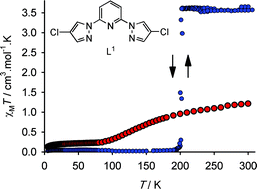Thermal and light-induced spin-transitions in iron(ii) complexes of 2,6-bis(4-halopyrazolyl)pyridines: the influence of polymorphism on a spin-crossover compound†
Abstract
The syntheses of

* Corresponding authors
a
School of Chemistry, University of Leeds, Woodhouse Lane, Leeds, UK
E-mail:
m.a.halcrow@leeds.ac.uk
Fax: +44 113 343 6565
Tel: +44 113 343 6506
b Institut de Chimie de la Matière Condensée de Bordeaux, UPR CNRS 9048-Université de Bordeaux 1, Groupe des Sciences Moléculaires, 87 Av. Doc. A. Schweitzer, Pessac, France
The syntheses of

 Please wait while we load your content...
Something went wrong. Try again?
Please wait while we load your content...
Something went wrong. Try again?
R. Pritchard, H. Lazar, S. A. Barrett, C. A. Kilner, S. Asthana, C. Carbonera, J. Létard and M. A. Halcrow, Dalton Trans., 2009, 6656 DOI: 10.1039/B907094J
To request permission to reproduce material from this article, please go to the Copyright Clearance Center request page.
If you are an author contributing to an RSC publication, you do not need to request permission provided correct acknowledgement is given.
If you are the author of this article, you do not need to request permission to reproduce figures and diagrams provided correct acknowledgement is given. If you want to reproduce the whole article in a third-party publication (excluding your thesis/dissertation for which permission is not required) please go to the Copyright Clearance Center request page.
Read more about how to correctly acknowledge RSC content.
 Fetching data from CrossRef.
Fetching data from CrossRef.
This may take some time to load.
Loading related content
